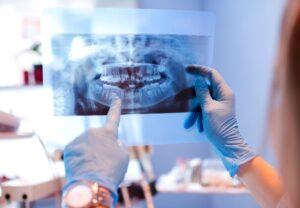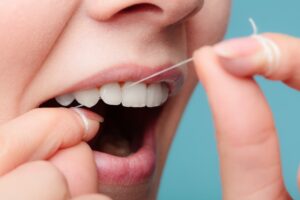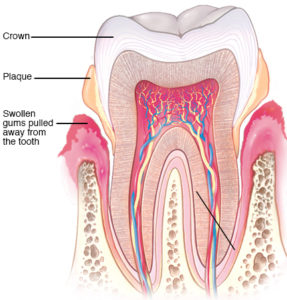Header logo
header top contact widget
Dry Mouth
Females & Males – Oral Health Differences
Posted on Jun 05, 2024 by William J. Claiborne, DDS MS
As a periodontist, I have an intense understanding of how oral health impacts the overall health of both males and females. However, my specialized skills also allow me to understand the unique factors that affect the oral health of our female patients.
As a result of hormonal fluctuations, females can face particular challenges when it comes to oral wellness. For example, pregnancy gingivitis is not uncommon in women during pregnancy. If not treated and resolved, however, it can develop into periodontitis (advanced periodontal disease) and subsequent tooth loss.
A good illustration of how women face unique oral health challenges was noted in findings shared recently on Fox News. (https://www.foxnews.com/health/women-experience-dental-health-issues-men-experts-say-heres-what-do-about)
Using a pH meter, the pH levels in saliva were tested on multiple people over the course of many years. The researchers found the pH of women’s saliva was frequently 5.5 or 6 – a lower saliva flow rate than men.
Saliva’s ideal pH rate is between 7 and 7.4. If the pH of saliva constantly drops below 5.5, the tooth enamel gets demineralized, which means it will be more prone to tooth decay. Because the aging process causes a lower flow of saliva, a drier mouth weakens teeth due to the slower remineralization or buffering capacity.
Below are some of the different phases of life that can be accompanied by various challenges to a female’s oral health:
Puberty: Estrogen and progesterone hormones produced during puberty increase blood flow to the gums. This changes how the gums respond to plaque, the sticky film of bacteria in the mouth. With this may be gums that bleed when brushing and become red, tender, and swollen.
Menstruation: The menstrual cycle causes hormonal changes that cause some women to experience symptoms such as swollen gums that turn bright red, canker sores, or gums that bleed easily. Referred to as menstruation gingivitis, this usually occurs just prior to the onset of the period and resolves in a day or so.
Oral Contraceptives: Taking birth control pills that contain progesterone cause some women to have gum tissue inflammation. This occurs from heightened sensitivity to the toxins produced from the overload of bacteria that form plaque. While many women have less gum reactions after the first few months, some medications can lower the effectiveness of oral contraceptives. This reinforces the need to keep your dentist updated on all medicines you take.
Pregnancy: With each trimester of pregnancy, hormonal levels can change. Pregnancy also causes increased progesterone levels, which can increase the risk for plaque formation. This can lead to pregnancy gingivitis, particularly during the second to eighth month of pregnancy. This condition causes the gum tissues to become swollen and bleed easily. Gingivitis is the first stage of gum disease, which is why it is important to have gingivitis fully resolved to prevent its further progress. Because studies have found that gum disease can increase the risk for preterm and low birth weight babies, obstetricians are urging their pregnant patients to be particularly diligent in maintaining good oral health.
Menopause: With age, a variety of changes can take place in our mouths for both males and females. A particular challenge is the decrease in saliva flow, leaving the mouth is less moist. Additionally, the side effects of certain medications can pose challenges to keeping the gums healthy. Without adequate saliva flow to keep the mouth cleansed and efficient in neutralizing the acids from plaque, the risk for gum disease is greater for females in menopausal years. Declining estrogen levels also place women at greater risk for bone loss or osteoporosis as well as inflamed gum tissues around the teeth (called periodontitis). When there is bone loss of the jaw, it can result in tooth loss. Receding gums are a sign of this bone loss since more of the tooth surface is expose to the causes of tooth decay.
Researchers in Romania studied the gender differences in oral health. Through an online survey of 600 adults, the study assessed attitudes, behaviors, and educational understanding related to oral health and dental services.
The results show that women have more positive attitudes towards dental services with higher oral health values, better self-care behaviors, and have higher oral health literacy than men.
While the study indicated that oral care attitudes and behaviors of men had different influencing factors, women were primarily influenced by their level of oral health literacy. The study also noted that differences in oral health attitudes and values for both genders can be based upon education.
https://www.ncbi.nlm.nih.gov/pmc/articles/PMC9604615/
This is a good reason to stay on top of how intricately your oral health is to your overall health. Because the bacteria of periodontitis can penetrate the bloodstream through weak gum tissues, it has been correlated to a long list of serious health problems.
Research has found that periodontal bacteria can trigger the development or worsen the likelihood of heart disease, stroke, some cancers (including pancreatic and lung
cancer), preterm babies, diabetes, arthritis, erectile dysfunction, Alzheimer’s disease and more.
Although gum disease can exist without obvious signs or symptoms, the most commonly noticed are:
• Red, swollen or tender gums
• Seeing blood in the sink when brushing
• Receded gums
• Loose or separating teeth
• Pus pockets on gum tissues
• Sores in the mouth
• Persistent bad breath
In our Asheville periodontal dental office, patients can begin with a private consultation. We are always happy to discuss oral health options with new patients. A referral is not needed.
Call 828-274-9440 to schedule.
Know How Summer Comes With Oral Health Risks
Posted on May 20, 2024 by William J. Claiborne, DDS MS
As an Asheville periodontist, there are two times a year I feel come with higher risks for keeping one’s oral health well-maintained.
One is during the Thanksgiving-Christmas season. During these times, people tend to consume food and beverages that are higher in carbs and simple sugars. And, they eat more frequently. I understand – it’s pretty hard not to sneak a piece of grandma’s fudge with a mid-morning cup of coffee!
Although the hardships to teeth and gums brought on by these indulgences may be diluted by swishing or an extra brushing during the day, summertime has its own set of challenges that are rather similar.
First, understand that any time you eat or drink something (other than plain water), an acid attack begins in the mouth. This acid flows in with saliva, bringing in an acid to break down food as its chewing; the body’s first stage of digestion. These acids are rather potent in that they can even soften enamel for 20-30 mins. Thus, when other acidic elements are introduced in the mouth, the higher levels of acid can leave precious tooth enamel at risk.
Below are things to keep in mind as we go into the official “it’s okay to wear white” season!
Oral acidity – Summer foods and beverages seem to come with a wealth of consumables that are high in acidity – garden fresh tomatoes, lemonade, water or tea with a squeeze of lemon, etc. Just know that they need to be diluted by swishing with water or drinking gulps of water while consuming.
Colas – I can’t say enough bad things about colas when it comes to oral health. While sodas, coffee, tea and wine are all highly acidic, the acidity levels in colas have been compared to nearly that of the levels in battery acid. Colas are highly acidic because they are infused with phosphoric acid, intended to add flavor. Phosphoric acid is so erosive it can remove rust from aircraft carriers and ships.
When these erosive acids are mixed with the acids that occur naturally in the mouth, there is a significantly higher potential to erode tooth enamel. Dental erosion can cause temperature sensitivity, pain, transparent teeth, cracking and darkening of teeth.
Also concerning is the way colas are consumed. Every time you sip a soda, an acid attack in the mouth is triggered for 20-30 minutes until eating or drinking ceases. Because colas are typically consumed slowly over long periods of time, the acid attack lasts that long plus another 30 minutes before subsiding. For colas containing sugar, this mixes with the acid in the drink and your digestive acids for an even greater level of destruction.
Accidents & injuries to the mouth – Outdoor sports and activities such as skiing, biking and baseball should all be done with a custom-made mouthguard in place. This is important for children and adults. Having a permanent tooth knocked out can be devastating.
If the worst should happen, a periodontist is your specialist in placing dental implants. And, by acting soon after the tooth is lost, you can preserve the natural contours of the gum tissues that arch the tooth. These arches of gums help to create a natural appearance when the replacement tooth is placed along with the “points” that dip slightly between each tooth.
A periodontist has advanced skills in the diagnosis and placement of the implant type best for individual needs. In our Asheville periodontal dental office, we use advanced imaging and implant guidance technology that helps to minimize treatment and optimize comfort with reduced healing time.
Oral Dryness – “Dry mouth” promotes oral bacteria by enabling rapid reproduction. When oral bacteria are able to linger in the mouth, they have an ideal warm, dark, moist environment. Without saliva serving as a continual rinsing agent to keep bacteria levels in the mouth under control, oral bacteria accumulate at a rapid pace.
Water intake helps to support saliva in the mouth to rinse bacteria and food particles from the mouth. Sufficient saliva flow helps in neutralizing the acids produced by oral bacteria and aids in preventing tooth decay and the development of periodontal (gum) disease.
By understanding where the risks lie, you can take proactive measures between visits to prevent things like cavities and gum disease.
An overload of oral bacteria initially reveals itself as plaque, at first. This is a sticky film that coats the teeth and gums, which is easily noticeable upon waking up. If not thoroughly removed each day, it can hardened at the base of teeth. This is known as tartar.
Tartar is a cement-hard colony of bacteria, which feed on tender gum tissues. This can cause tender gums that bleed easily when brushing and more frequent bad breath.
This early stage of gum disease is known as gingivitis. If not resolved quickly, it can easily progress. Periodontal disease is an inflammation of the gum tissues that causes bleeding, swelling, persistent bad breath and gum recession. As it worsens, gum disease can enter the advanced stage of periodontitis. In this, infectious oral bacteria attack the area below the gum line, including bone and tissues that support natural teeth.
The bacteria can also enter the bloodstream through tears in diseased gums. The inflammatory nature of this bacteria can trigger a number of serious health problems, including heart disease, stroke, some cancers, diabetes, arthritis, pre-term babies and more. Periodontal disease is also the nation’s leading cause of adult tooth loss.
Summer is a wonderful time for vacations and being more active outdoors. However, don’t let your daily oral care regimen result in costly repairs down the road. Avoid taking “time off” from your twice-a-day oral hygiene routine so bacterial growth doesn’t require dental treatment as a result.
When vacationing, some tips for your oral upkeep include:
• When packing, place your tooth brush, floss and toothpaste in one container separate from other items. Once you arrive at your destination, place this by the sink so they are handy each morning and evening.
• Take along sugarless gum to help you maintain sufficient saliva flow in the mouth. This aids in removing bacteria before it builds into the stick film that forms plaque.
• Brush at least 2 minutes per brushing followed by brushing your tongue to dislodge embedded bacteria.
• If you can’t brush right after a meal, swish with water or chew sugarless gum.
• Drink lots of water throughout the day to keep oral tissues moist.
Call 828-274-9440 if you have questions about your gums or if you are experiencing symptoms of gum disease. This disease will only worsen without treatment. You may also wish to begin with a consultation.
You are invited to visit our website to learn more about dental implants, sedation options (including “twilight sleep”) and advanced technology.
Men – Take On The Challenges In Oral Health Upkeep.
Posted on May 05, 2024 by William J. Claiborne, DDS MS
If you’re a male, or have ones in your life you love, the following information will be good-to-know. This is filled with reasons why you (or they) should make oral health a priority.
Let’s begin with the hazards of gum disease. According to a survey by the Centers For Disease Control & Prevention (CDC), only 66% of males brush their teeth twice or more a day (compared with 86% of females).
Flossing stats weren’t much better, but that proved to be the case with both sexes. Only 49% in the survey said they were daily flossers with 1 out of 3 with the misconception that seeing blood in the sink when brushing is normal (it’s not).
Periodontal (gum) disease is the result of an over-accumulation of oral bacteria. It begins with Gingivitis.
Gingivitis is caused by the toxins in plaque. Plaque is the sticky layer of bacteria that coats teeth and gums. When not removed (through regular brushing and flossing), it can harden into a form known as tartar (that can no longer be brushed away).
Gingivitis is typically treated with a professional cleaning and thorough at-home care. Some cases may require root planing and deep scaling procedures to rid the gum tissue of debris pockets (pus-filled bulges on gum tissues). This procedure reaches bacteria that has penetrated beneath the gum line.
The next stage of gum disease is known as chronic periodontal disease. The most common form of gum disease, this is characterized by inflammation beneath the gum line with damage to gums and bone tissue. At this level, treatment includes scaling and root planing along with antimicrobial treatments. In some stages, surgical procedures are also necessary for pocket reduction. Some cases require tissue grafts to strengthen the bone and improve the appearance of the smile.
As gum disease worsens, it moves to periodontitis, a more aggressive stage of gum disease. Periodontitis has similar symptoms to those listed above but tends to progress at a faster pace. Because this stage of gum disease is more difficult to combat, treatment is the same treatment needed for chronic periodontal disease along with surgical intervention. A combined treatment of scaling, root planing, antimicrobial, and surgical procedures may save oral tissue and bone.
Periodontal disease is the nation’s leading cause of adult tooth loss, affecting over 47% of adults ages 30 and over. Research has found that gum disease is higher in men (over 56%) than in women (38%).
The Centers for Disease Control & Prevention (CDC) notes that men are typically less likely to sufficiently maintain their oral health. Oral health should be especially concerning for men since they have some challenging odds against them as far as health statistics go. These include:
• Men have higher rates of periodontal (gum) disease, tooth loss, and oral infections. Because statistics show that men typically have poorer dental habits than women, they tend to have more dental health problems. Men can’t blame this on biological predisposition as the statistic is based upon lifestyle choices (such as not brushing, etc).
• Men tend to have higher blood pressure, putting them at an increased risk for heart disease later in life. Medications that treat these conditions can cause dry mouth, which ups the risks to their oral health.
• Elderly men typically have fewer teeth than women of the same age, and need dentures more than women. Although research shows a correlation between tooth loss and body mass index, elderly men having few teeth is the result of poor dental habits and attention to dental health accumulated over time.
• Oral cavity and oropharyngeal (throat) cancers are twice as common in men than in women. It is suspected that this is due to men being more likely to have a history of tobacco and alcohol use.
• HPV-related oropharyngeal cancers occur more often in men. Human Papilloma Virus (HPV) is the most common sexually transmitted infection in the U. S. HPV can lead to certain types of cancer and is thought to cause 70% of oropharyngeal cancers in the U.S. The development of oropharyngeal cancer due to HPV is about three times less prominent in females than in men of the same age.
While a healthy smile is important to both genders, older adults should pay particular attention to having a good oral health. By CDC estimates, approximately 13% of adults ages 65 – 74 have no teeth. For people ages 75 and older, that number jumps to 26% (over one-fourth!).
Too, ALL ADULTS should be concerned with the overall health repercussions related to the inflammatory bacteria of gum disease. Able to enter the bloodstream through tears in diseased oral tissues, these bacteria can trigger inflammatory reactions elsewhere in the body. This has been associated with the development or worsening of heart disease, diabetes, some cancers, diabetes, arthritis, erectile dysfunction, elevated PSA levels, and respiratory diseases.
Also applicable to all adults, the Journal of Periodontology shared nine risk factors for tooth loss due to periodontal (gum) disease, including …
• Being over age 35
• Being male
• Not having professional dental care
• Not brushing teeth
• Smoking
• Being diabetic
• Having high blood pressure
• Having rheumatoid arthritis (RA)
Treating gum disease before it becomes severe can be done comfortably and affordably. In our Asheville periodontal dental office, we use cutting-edge technology that often minimizes treatment needs, lessens healing time, and optimizes comfort.
If dental fears have caused you to delay or avoid having regular dental care, consider beginning with a consultation. As a periodontist, I know many individuals like that this occurs in a comfortable, private consultation room. We can discuss the use of oral or I.V. sedation (sleep dentistry, or “twilight sleep”) during procedures. These are administered safely with patients monitored with advanced safety equipment throughout treatment.
If financial constraints are an obstacle in receiving treatment, we offer several payment plans. Most are interest-free with no down payment required (for qualified individuals).
Call 828-274-9440 to begin with a private consultation to discuss your best options. New patients are welcome and a referral is not needed.
Sources:
https://www.perio.org/consumer/gum-disease-and-men
https://www.perio.org/consumer/gender-differences
https://www.ncbi.nlm.nih.gov/pmc/articles/PMC4544688/
https://pubmed.ncbi.nlm.nih.gov/20116657/
https://www.cancer.org/cancer/oral-cavity-and-oropharyngeal-cancer/causes-risks-prevention/risk-
https://www.colgate.com/en-us/oral-health/hiv-aids-and-stds/dental-care-hpv-and-men#
Healthy Gums Advantageous To A Healthier YOU!
Posted on Apr 22, 2024 by William J. Claiborne, DDS MS
Periodontal (gum) disease and subsequent tooth loss has damaging effects to an individual, far beyond the mouth. When this was suspected decades ago, it prompted national agencies to track the oral health of the U.S. population. Using this extensive data, studies have revealed some interesting statistics, including how various age groups fare when it comes to oral wellness.
The following is mostly information pulled from the National Institutes of Health’s (NIH) “Oral Health In America” report. Released in December 2021, the findings were the culmination of years of research assembled by more than 400 contributors.
On a positive note, the percentage of Americans who have experienced tooth loss has declined since the 1970’s. As of 2016, complete tooth loss has fallen by more than 75% for adults between the ages of 65 – 75 years. Unfortunately, there is not good news when it comes to tooth decay – for nearly any adult age group.
For adults between the ages of 20 – 64, cavities have affected 90% and gum disease exists for nearly 50% of adults aged 45 – 64 years. This should be a concern for every American. This is because research has determined that the bacteria of periodontitis (advanced gum disease) can trigger or worsen a long list of serious health problems.
The list includes:
• Stroke
• Coronary Artery Disease
• Arthritis
• Diabetes
• Preterm & low birth weight babies
• Some Cancers (including oral and pancreatic)
• Alzheimer’s disease
• Impotency, Erectile Dysfunction (ED)
• Prostatitis (elevated PSA levels)
In addition to poor oral hygiene routines at home and avoiding regular dental cleanings and exams, high-risk behaviors (such as use of tobacco, opioids, and alcohol) accentuate the risks of gum disease.
Although gum disease can begin without obvious signs or symptoms, the most commonly noticed are:
• Red, swollen or tender gums
• Seeing blood in the sink when brushing
• Receded gums
• Loose or separating teeth
• Pus pockets on gum tissues
• Sores in the mouth
• Persistent bad breath
While the report found that there are stark differences in adult groups who had less access to having regular oral health care, disparities also stem from underlying economic, demographic, and societal inequities.
Below are some of the oral health variations pertaining to certain groups.
ADOLESCENTS
During the past 20 years, the percentage of adolescents (ages 12 − 19) having at least one molar with a sealant applied has nearly tripled, from 18% to 48%. That’s a good thing. Even so, there has been no decline in untreated tooth decay in adolescents since the last surgeon general’s report twenty years ago.
High caries (cavities in teeth) experienced in early childhood is the strongest indicator of caries problems that will be experienced in adolescence and adulthood. This means that when the factors contributing to developing cavities in childhood persist, the incidence of caries affecting permanent teeth will continue to increase during adolescence. Likewise, misalignment of teeth that exist or develop during adolescence can substantially impact eating, speech, gum health, and even psycho-social development. (Imagine a teen with teeth so mispositioned that they are ridiculed by peers.)
OLDER AMERICANS
There is good news for our older population (Americans over the age of 65). Their overall oral health has significantly improved over the past two decades with fewer teeth being extracted. Additionally, the proportion of the population with edentulism (no remaining natural teeth) is at an all-time low.
The not-so-great news… tooth loss remains a problem for older adults. Today, 1 in 6 Americans have no remaining natural teeth. At this rate, by the year 2030 (just 6 years from now), the 65-&-over age group without teeth will increase to 1 in 5.
For adults over the age of 75, the challenges are even greater. Over 54% have fewer than 21 remaining teeth with the number increasing to 80% for those living in poverty. With age also comes the increased prevalence of systemic diseases that may impact the mouth, making older adults more susceptible to oral health issues. (This includes heart disease, diabetes, arthritis, etc.)
Fortunately, things are moving in a positive direction for older adults, with more keeping their teeth than any previous generation. This has largely been the result of having increased attention on the benefits of prevention and improvements in treatments for gum disease and cavities, along with a decrease in the rate of smoking. (About 8 of every 100 adults – 8.3% – of adults 65 years and older were reported to smoke in 2023.)
WOMEN
Women have unique oral health concerns due to changing hormone levels based on menstrual cycles, pregnancy, and menopause. These fluctuations can raise the risk of oral problems that effect teeth or gums. Health issues, such as diabetes, can also affect the oral health of females.
To keep your teeth healthy, it is important to remove dental plaque. This is a sticky, colorless film of bacteria that coats teeth and gums. Plaque buildup can cause tooth decay and gum disease.
Even teeth that already have fillings are at risk for tooth decay. Plaque can build up underneath a chipped filling and cause new decay. And if there are areas in your mouth where your gums have pulled away from the teeth (known as receded gums or gum recession), the exposed tooth roots can decay as well.
It’s important – for all ages – to be committed to their oral hygiene time at the sink, at least twice a day. Devoting these minutes to the care of your teeth and gums will pay off in future years, helping to minimize costs for dental repairs and time in treatment. And, when early ages get into the habit of an oral care routine at home, they are more likely to carry that into adulthood.
Here are some easy brushing tips:
• Use fluoride toothpaste, which is an ingredient of many products. Fluoride protects teeth from cavities, helping to strengthen the tooth’s hard outer surface – the enamel.
• Angle the bristles toward the gumline so they can sweep away bacteria between the gums and teeth.
• Brush gently using small, circular motions. Do not scrub hard back and forth, which can wear down tender gum tissues and wear away tooth enamel.
• Brush all sides of each tooth and the tops (where debris and bacteria can hide within grooves).
• Brush your tongue, especially towards the back where the majority of bacteria embed. Swish well with water at least twice afterwards.
Cleaning between teeth to remove plaque is also part of a good oral hygiene routine. If plaque is not removed, some of it can harden below the gum line and irritate the gums. The gums become red, swollen, and may bleed easily. These are signs of gingivitis. Gingivitis caused by plaque buildup is a mild form of gum disease, and you can usually reverse it with daily brushing and flossing.
If plaque stays on your teeth for too long, it can harden. This hardened plaque is called calculus, or tartar. The only way to remove tartar is to have your teeth cleaned by a dentist or dental hygienist. If the tartar is not removed, the gingivitis can get worse and lead to more severe gum (periodontal) disease. In advanced stages, gum disease causes sore, bleeding gums; painful chewing problems; loose teeth; and even tooth loss.
Here are some additional ways to keep a healthy smile with practical measures.
- Floss to remove plaque, and food particles, from between your teeth.
- Visit the dentist for routine check-ups and professional cleaning. If you are at a high risk for tooth decay (for example, if you have a dry mouth because of medicines you take), your dentist or dental hygienist may give you a fluoride treatment, such as a varnish or foam during the office visit.
- Drink fluoridated water. Drinking water with the right amount of fluoride protects your teeth throughout the day.
- Don’t smoke. Smoking increases your chance of gum disease. If you smoke and want to quit, there are many resources to help you: FDA’s Center for Tobacco Products, CDC’s Quit Smoking website, and the BeTobaccoFree.gov website.
- If you are planning to become pregnant, have a dental checkup. Because of hormonal changes, pregnant women may develop gingivitis and experience gums that are swollen and bleed easily. During pregnancy, it is especially important to practice good oral hygiene to maintain the health of your gums.
- Eat a diet that is low in sweets and sugary drinks.
A periodontal specialist is your best advocate in restoring or maintaining healthy gums. In addition to the skills in treating all stages of gum disease (from gingivitis to periodontitis), a periodontist specializes in the selection and placement of dental implants.
If you have signs or symptoms that may be indicative of gum disease, please know this disease will only worsen without treatment. Call 828-274-9440 to schedule an appointment or ask to begin with a consultation.
If dental fear is a concern, we can discuss oral or IV sedation options. These are administered safely with skilled staff members who use advanced safety equipment throughout your care.
Additionally, if you’ve delayed care due to cost, we office several payment plans that many patients find helpful. These plans can break costs into monthly payments, often with no down payment required.
Sources:
https://www.nidcr.nih.gov/health-info/oral-hygiene
https://www.nidcr.nih.gov/research/oralhealthinamerica/section-2b-summary
https://www.nidcr.nih.gov/research/oralhealthinamerica/section-3b-summary
https://www.nidcr.nih.gov/research/oralhealthinamerica/section-3a-summary
https://www.womenshealth.gov/a-z-topics/oral-health
https://www.cdc.gov/tobacco/data_statistics/fact_sheets/adult_data/cig_smoking/index.htm
Recent Posts
Categories
Archives
- September 2024
- August 2024
- July 2024
- June 2024
- May 2024
- April 2024
- March 2024
- February 2024
- January 2024
- December 2023
- November 2023
- October 2023
- September 2023
- August 2023
- July 2023
- June 2023
- May 2023
- April 2023
- March 2023
- February 2023
- January 2023
- December 2022
- November 2022
- October 2022
- September 2022
- August 2022
- July 2022
- June 2022
- May 2022
- April 2022
- March 2022
- February 2022
- January 2022
- December 2021
- November 2021
- October 2021
- September 2021
- August 2021
- July 2021
- June 2021
- May 2021
- April 2021
- March 2021
- February 2021
- January 2021
- December 2020
- November 2020
- October 2020
- September 2020
- August 2020
- July 2020
- June 2020
- May 2020
- April 2020
- March 2020
- February 2020
- January 2020
- December 2019
- November 2019
- October 2019
- September 2019
- August 2019
- July 2019
- June 2019
- May 2019
- April 2019
- March 2019
- February 2019
- January 2019
- December 2018
- November 2018
- October 2018
- September 2018
- August 2018
- July 2018
- June 2018
- May 2018
- April 2018
- March 2018
- February 2018
- January 2018
- December 2017
- November 2017
- October 2017
- September 2017
- August 2017
- July 2017
- June 2017
- May 2017
- April 2017
- March 2017
- February 2017
- January 2017
- December 2016
- November 2016
- October 2016
- September 2016
- August 2016
- July 2016
- June 2016
- May 2016
- April 2016
- March 2016
- February 2016
- January 2016
- December 2015
- November 2015
- October 2015
- September 2015
- August 2015
- July 2015
- June 2015
- May 2015
- April 2015
- March 2015
- February 2015
- January 2015
- December 2014
- November 2014
- October 2014
- September 2014
- August 2014
- July 2014
- June 2014
- May 2014
- April 2014
- March 2014
- February 2014
- January 2014
- December 2013
- November 2013
- October 2013
- September 2013
- August 2013
- July 2013
- June 2013
- May 2013
- April 2013
- March 2013
- February 2013
- January 2013
- December 2012
- November 2012
- October 2012
- September 2012
- August 2012
- July 2012
- June 2012


